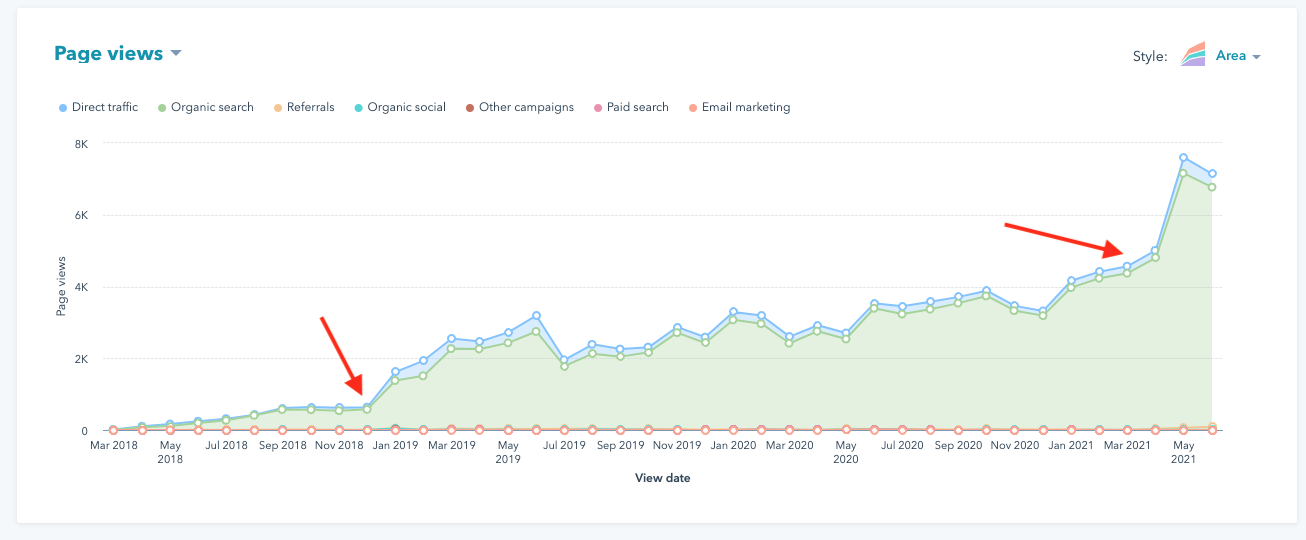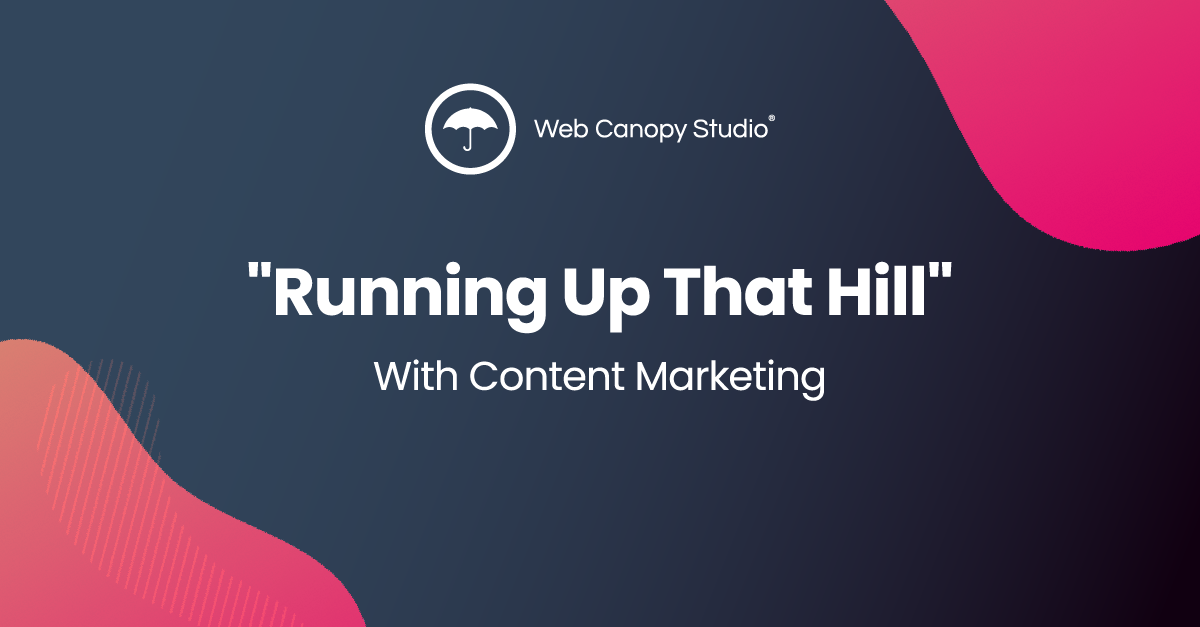What Kate Bush Can Teach Us About Repurposing Content
Season four of Stranger Things is upon us, and it's made for some great television. I'm particularly drawn to the show because it takes place in Indiana where I'm from, and it takes place in the mid-80s when I was born. So, I've naturally been drawn to the show, the setting, and the music they play.
Watch the video here:
Listen to the podcast here:
One of the coolest things about season four has been the reintroduction of Kate Bush into the musical world.
In 1985, she released her song, "Running Up That Hill (Make a Deal With God)" as the first single from her Hounds Of Love album.
The song reached #3 on the UK Singles Chart and #30 on the Billboard Hot 100 at the time.
It was the highest the song ever reached, until millions of people heard it for the first time on Stranger Things.
Now it has resurged, reaching the top five on the Billboard Hot 100, topped the UK's charts for three consecutive weeks, and it even hit #1 on the Billboard Global 100 for a moment.
It has been used 1.8 million times in TikTok videos and it has been streamed 465 million times globally, which is a 16,000% increase before the show aired.
And it's now the most-streamed song on both the US and global markets for the last few weeks.
It's fascinating that it has not only become such a pivotal part of the show, but it has become so important to millions of people.
Before Stranger Things, pretty much the only people who knew about the song were the people who grew up with Kate Bush, or happened to catch a replay of the song when it was used in other UK productions in the 90s.
So we've got two whole generations — Millennials and Gen Z — who are hearing the song for the first time, and they're learning how good it actually is.
Can Old Content Be Repurposed?
The success of "Running Up That Hill" has raised a question for me and for the team here at Web Canopy Studio:
Can old content become relevant again?
In the marketing world, it's pretty easy to put out a piece of content and watch it go off into the ether and die, where we never really hear from it again.
But it doesn't necessarily always have to be that way.
A lot of marketers will tell you there should be some kind half life with your content.
In other words, you should produce content that should slowly decay over a period of time because it's been distributed on different platforms.
You can extend that life by chopping up and repurposing your content into different short cycles in different areas.
For example, putting up a 10-minute video on YouTube, then breaking it up and publishing short reels on Instagram, and even shorter bits, like a trailer, on TikTok.
Even so, it's only going to be around for a relatively short time.
YouTube will have a lot more longevity and it will remain and produce results because of the newsfeed algorithms, related videos, and because YouTube is the world's second-largest search engine.
So can you revive an old piece of content and wake it up to the point where it's functional and useful to your brand, and can even outperform its original iteration?
How To Give Life To Old Content
We actually tested this several years ago, and it was pretty cool to see how this turned into something we still see fruit from today.
In fact, it became a major component of how we think about web traffic and how to get people to respond to our brand.
We published a blog article in February or March 2018 called The 3 Sales Strategy Examples Every Company Should Use in 2018, which included several helpful hints about selling and marketing.
There were a couple hundred reads on the article, and we shared it on social media, but then it just flatlined — it never did anything after that.
Some time later, we went back and looked at the analytics of where we ranked for different factors on different blogs and pages on our website, and we found that this particular blog post was on page four or five of Google's search results.
Of course, no one is ever going to click that far back to find an article like that, but it was still pretty high for some strong keywords, specifically sales strategy examples. (Because every salesperson and their brother has written about sales strategies.)
We had an a-ha! moment and thought, "what if we repurposed the article and gave it some new life?"
It had been around 800 words long with a handful of paragraphs and some ideas for sales, sales strategies, and examples.
At the end of 2019, we beefed it up and added more written content.
We added some videos, and even transcribed some of the videos and turned them into actual written content. (Sort of like this particular blog post: It's based on a podcast episode I did recently.)
We put all of that content inside the blog itself, and we saw some pretty substantial growth!
The web traffic started moving up almost overnight and we reached the second page of Google for that same term.
That term was getting thousands of searches per month, which meant we were within arm's reach of getting some serious web traffic.
So we continued making those changes and improvements. We made two major changes to the blog article, and we made some other smaller modifications as time went on.
Even today it still delivers traffic to our site consistently, generating thousands of site visits each month (as opposed to just a few hundred when it first was published).
You can even see on the graphic below (screenshot from HubSpot) the two major points on the graph where we made the biggest changes.
By making those improvements and adding more information, we got more people to be interested in it.

Finding the right kind of content
So how do you take content that has been living on a metaphorical shelf somewhere and breathe new life into it? How do you make it relevant and valuable again?
This is especially important because we don't always have time to crank out new marketing content over and over again, at least not without sounding boring, repetitive, and like we're grasping for straws.
So we need to look for pages that we might want to re-purpose or reawaken. To do that, we need tools like Semrush.
There are several other tools out there that do a decent job of looking at keywords and your ranking for specific pages, but I think Semrush is far and above the best one out there.
It will tell you all of the pages, but will specifically look at the best terms and opportunities for your website.
That's how we look for our own opportunities.
Not necessarily the things we or a client rank in the top 20 for; rather, we're more interested in the middle of the road — around 50th or 60th.
We explore other relevant keywords that are also getting decent traffic, because we know that's a great way for us to expand on that content.
It's really powerful, because not only do we know the page and content we're targeting, we're also getting a list of other content types and topics that we can include on our pages.
So if you have blog articles that are two, three, or even four years old and still relevant to Google, there are some great opportunities to revive them and bring them back to life and get some compelling traction.
How to expand your old content
My favorite way to expand old content is through videos, but of course, you have to be comfortable in front of a camera.
Create Video Content
If you could create videos just around answering questions, that's all you really need.
It doesn't need to be high quality. Using the devices and software you already have will give you an awesome opportunity to share your thoughts on a specific topic in short-and-sweet video that you can reuse in many formats.
Ideally, you know the subject matter, which is one thing people get nervous about. (That is, if they're not comfortable with the subject matter, they're more likely to be nervous.)
You can literally just pull out your iPhone and talk into it, or set up a tripod and give it a go.
Or get even fancier, like the video podcast I did for this blog article, and put a real camera on a real tripod in front of a real microphone.
Podcasts
Another content form is a podcast, again like this one. (Did I mention I got this blog article from a podcast? I think I did.)
Do you have podcast episodes you can take content from?
Can you do a podcast episode about a specific topic and transcribe it, and put it into the website itself?
Or can you interview someone and transcribe it?
And if you did a video podcast...
Now you have three places to publish your content: YouTube, your podcast platform, and your blog.
Embed the video on your website and the podcast itself elsewhere on your website, and now you've got three media formats on one website.
One thing we have noticed is that pages with embedded YouTube videos generally perform better in search rankings, mostly because Google owns YouTube. And it's much easier to win a search with an optimized YouTube video than it is to win with an optimized web page. So put a fully-optimized YouTube video on a website, and voila! If nothing else, it's another way for people to stay on your page to watch the video, which helps your Time On-Site stats (another Google search rank factor).
Crowd Source Your Content
Another method we use at Web Canopy Studio: I produce a Google Survey or Google form with two or three questions on it.
I'll send it to our team and ask them to jot down their thoughts or answers to some simple questions.
And in many cases, I'll ask something like, "What are 3 ways would you recommend a client change their website to solve XYZ?" or "Give me three things that you see clients misunderstand or don't do properly."
Then I typically record a video about the top three solutions, I'll put that on a podcast, we'll turn it into a blog post, and we'll share this in multiple ways on social media... all because the team came up with fantastic ideas on their own.
I'll end up having 25 different great ideas. And if I'm lucky, I can get a second and third piece of content out of the remainder of the ideas or use them elsewhere.
Repurpose Old PDFs, Webinars, Checklists, Guides, & Presentations
Finally, (and here's my big pro tip for those of us who have been around a long time):
You probably have a lot of old, expired content that just lives deep, deep, in the back of the shelves of a forgotten virtual storeroom. That content still has some life in it. You can use it in a lot of different ways.
For example, let's say you have some old PDF guides and checklists that you created five to ten years ago.
You can easily repurpose that information into these same kinds of content pieces.
You can take presentations you did back in the 2010s for different industries, conferences, and events.
You can take information that you wrote for a guest post on another website or with other brands.
Or you can transcribe an old webinar you did for your clients.
There are a lot of transcription tools like Otter.ai or, our favorite, rev.com, which you can turn old audio and video content into blog posts. In fact, we used it to turn my podcast—you've heard this before, I'm pretty sure of it!
I recommend using this old forgotten content because, as Kate Bush and Stranger Things have shown us, you can give life to old content on a new medium in a way that wasn't even conceivable.
Wrapping It All Up
"Running Up That Hill" was released on CD and vinyl records in 1985, and no one had ever even heard of the Internet, let alone thought we could watch TV on it.
It sat in thousands of Gen X CD collections and was occasionally heard during bouts of nostalgia or very rarely on SiriusXM's "First Wave" channel.
But not many got to experience the joy of Kate's music until the Duffer Brothers used it in a show about things that happened 36 years ago.
It received new life.
It was re-energized and given to new people who would have never otherwise had any exposure to it whatsoever.
It's done great things for Kate, for her brand, for Stranger Things, and for Netflix.
So how can YOU use that same kind of strategy and bring back things we have produced a few months ago or even 15 years ago?
Well, for starters, begin by going through the list I mentioned above and find all the items you can repurpose and recharge.
But if you need to take your website and your conversion to the next level, then you need to check out our program called The Website Accelerator.
Curious what that is (an awesome program), how long it takes (about 8 weeks), what you'll get (coaching, resources, templates, content copy & more), and other questions about this feature?
You can check out The Website Accelerator here.
You'll thank me after :)
Cheers




